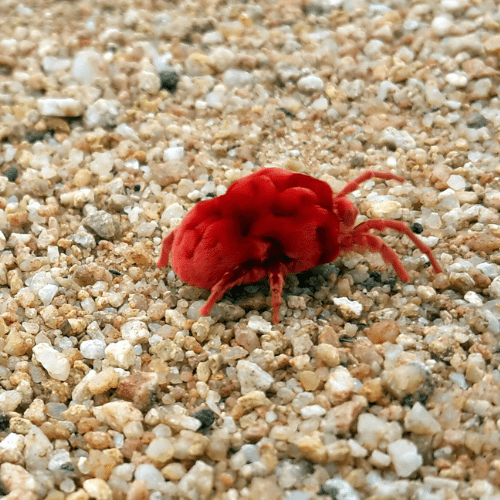Chigger

Proud Supporter of Disabled Veterans
No Contracts
Services provided without written contracts.
Introduction to
Chiggers, also known as harvest mites or red bugs, are the larval stage of a type of mite belonging to the Trombiculidae family. These tiny, reddish mites are notorious for their intensely itchy bites, which can cause significant discomfort and skin irritation. Chiggers are commonly found in grassy and wooded areas, where they attach to hosts and feed on skin cells. Understanding the biology, habits, and effective prevention methods for chiggers is essential for minimizing their impact and enjoying outdoor activities without the nuisance of chigger bites.
Recognition
Chiggers are tiny, measuring less than 1/150 of an inch (about 0.4 mm) in their larval stage, making them almost invisible to the naked eye. They are typically red or orange in color and have six legs, distinguishing them from adult mites, which have eight legs. Chiggers are often found in clusters on vegetation, waiting to attach to a passing host. They are commonly mistaken for other small red mites or insects, but chiggers can be identified by their intense itching bites and the red welts they leave on the skin. The bites are usually found in areas where clothing fits tightly against the skin, such as waistbands and sock lines.
Biology
Chiggers undergo a complex lifecycle with four stages: egg, larva (chigger), nymph, and adult. Female chiggers lay eggs in the soil, which hatch into six-legged larvae. These larvae climb onto vegetation and wait for a host to pass by. Once attached to a host, chiggers inject digestive enzymes into the skin, breaking down skin cells for them to consume. After feeding for a few days, the larvae drop off and transform into eight-legged nymphs and eventually into adults. Adult chiggers do not bite humans or animals and primarily feed on plant material. The entire lifecycle can take several months, depending on environmental conditions.
Habits
Chiggers prefer warm, humid environments and are commonly found in grassy fields, forests, gardens, and areas with dense vegetation. They are most active during the warmer months, from spring through fall. Chiggers do not burrow into the skin but attach to the surface and inject enzymes to feed. They typically bite in areas where clothing is tight against the skin, such as around the waist, ankles, and behind the knees. The itching and redness caused by chigger bites are due to the body’s allergic reaction to the enzymes. Chiggers can be transported into homes on clothing and pets but do not typically infest indoor environments.
Prevention
Preventing chigger bites involves a combination of personal protection and environmental management. When spending time in areas where chiggers are common, wear long sleeves, long pants, and high socks, and tuck pant legs into socks to minimize exposed skin. Use insect repellents containing DEET, permethrin, or picaridin on clothing and exposed skin. After spending time outdoors, shower promptly and wash clothes in hot water to remove any chiggers. Maintain your yard by regularly mowing the lawn, trimming vegetation, and removing leaf litter to reduce chigger habitats. Creating barriers with wood chips or gravel around play areas and paths can also help minimize chigger exposure.
Professional
If chiggers become a persistent problem in your yard or outdoor areas, professional pest control services can provide effective solutions. STL Pest Control offers comprehensive treatments to reduce chigger populations in infested areas. Their technicians are trained to identify chigger hotspots and apply appropriate acaricides and integrated pest management techniques. In severe cases, they may recommend ongoing maintenance plans to keep chigger populations at manageable levels. Professional services ensure thorough and long-lasting control, providing peace of mind and a more enjoyable outdoor experience.



Our Office







